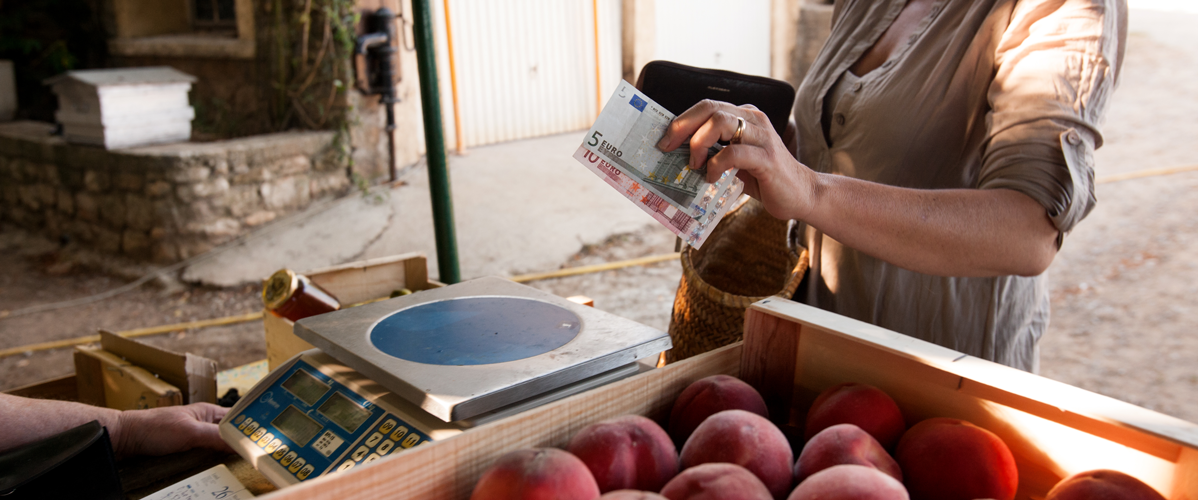“The subject of a ‘cashless society’ catalyzes a disparate set of initiatives and discussions around the advantages and disadvantages of cash and non-cash.”
This would spell the end of cash in favor of digital payments using chip-embedded bank cards or QR codes scanned on mobile phones, wristbands, or direct debits. Local currencies are gradually beginning to digitize (Blanc et al., 2020, p. 41) while cryptocurrencies, made famous with the 2009 launch of Bitcoin, and based on the blockchain registry (Canard, Sanders, 2018) are competing with national currencies: their hope is to compete with the private banking system in decentralized and libertarian fashion. Yet Bitcoin’s role as an alternative means of payment has gradually been eclipsed and it is now a financial asset (Gasull, 2019). In September 2021, El Salvador became the first country in the world to allow Bitcoin as a legal currency like the US dollar, despite reluctance on the part of the public, economists, and international financial organizations. Conversely, cash is expensive to produce and use, can be counterfeited, used for illegal activities, tax evasion, or for engaging in undeclared work. It is, therefore, in the interest of governments to replace it with digital currency, which is easier to monitor and trace. The pandemic re-opened the public debate over the future of cash, fueled by worries about the transmission of the virus on bills and coins, and prompting talk among digital idealists about the explosion of contactless and mobile app payments in the wake of the fintech economy – those companies born as a result of digital developments and the opening up of the banking market to non-banking players through the European directives of 2007 and 2015. In France, contactless payments increased as a share of all credit card payments from only 30% in September 2019 to over 65% in early June 2020 (1).
“Cashless society” is an umbrella term that encompasses and catalyzes a diverse and disparate set of initiatives, innovations, and discussions about the advantages and disadvantages of cash and non-cash (Kahn, 2018; Théret, 2019), in addition to the intrinsic value of digital money data (Beauvisage, 2021). Are the days of cash numbered? Is a cashless economy a realistic short- or medium-term goal? What if, one day, cash ceases to exist? What are the arguments for and against cash and what is driving the economic behavior underpinning these arguments? Are there any major efforts underway to protect cash? And what would physically happen to all the cash currently in circulation?
By analyzing the media discourse and industry literature, we can make a real effort to lay out what would be at stake for society and the economy if hard currency were digitalized and cash essentially disappeared in Europe (in particular in France) and the United States. The topic of a cashless society is first introduced with an analysis of the economic, infrastructural, and political factors driving the demise of cash, and the resulting cashless society model. How are material and non-material representations of money and economic belief systems informed by socio-economic institutions? How do these institutions frame its daily use and define the moral framework within which money fits into regulatory and social oversight bodies?
The dematerialization/digitalization of cash, an old idea
In contrast to cash (bills and coins), cashless payment methods represent systems that allow funds held in accounts to be transferred in order to fulfill a payment order (card, transfer, debit, check, etc.). Historians studying twenty-five centuries of monetary history point to the ancient nature of currency dematerialization (advent of bills of exchange, abandonment of the gold standard, transition from money tied to the weight of the precious metals that make compose it to fiduciary currency, introduction of accounting bookkeeping) and its countless material forms from the ancient Greek “drachma” to “Bitcoin” (Hochard, 2020).
More recently, digital resources in the 1960s and 1970s fueled the ambition of “digitizing” money and a “cashless society” in the US retail financial services sector(Bátiz-Lazo, Haigh et Stearns, 2014) with the plan to establish national and international banking markets for the computerization of economic transactions: people would not be required to carry cash or checks; instead, they could pay electronically using ID cards that would be linked to bank accounts.
Efforts to build payment markets with a system based on a few square centimeters of plastic, i.e., “bank cards,”show the long journey of standardizing and normalizing commercial transactions (SEPA, Visa, MasterCard, etc.) in many geographical areas: North America, Central and Eastern Europe, Russia, Asia, etc. The genesis and expansion of the markets for such “plastic money” has undergone a number of institutional adjustments such as establishing programs to collect data on customer solvency, standardizing credit card networks, and facilitating trading. Although it varies widely across countries around the world, the credit card market, a major factor in the 2000s after overcoming the inflationary difficulties of the 1990s, was based on two separate transactions: payments involving increasing numbers of people with bank accounts, and the use of consumer credit available independently of debit cards.
Outlook for a cashless society
Over the past decade, several countries have been actively engaged in programs that replace cash with electronic payment systems to manage social transfers (e.g., Mexico or South Africa), or more generally to eliminate cash from financial transactions (India, China). In terms of private initiatives, the last decade has seen a growing number of e-portfolio and mobile payment services. These services have been very successful in both northern countries (Apple Pay, Google Pay, Square, etc.), and in southern countries (M-pesa, Orange Money, etc.). In sub-Saharan Africa for example, cell phones have become the preferred way of accessing both the Internet and financial services via mobile money (Berrou, Mellet, 2020) in an environment that strongly promotes financial inclusion and low cost services. Phone operators—the new financial intermediaries—have been able to formalize traditional informal practices by building markets for these new services. In Europe, these commercial developments are permitted and facilitated under the 2007 and 2015 DSP2 regulations for opening up the banking market, which may lead to disintermediation of the banking community and pave the way for new players (Orange Bank, Fortuneo, etc.) (Toutain et al., 2018). In France, 38% of French people already used a mobile payment app in 2020 according to the 2021 Kantar/Paylib barometer. These different initiatives, both private and public, have, in some cases, been actively supported by networks of players such as the Better Than Cash Alliance, which include companies such as MasterCard, Visa, PayPal, Citibank, and Microsoft, through the Bill and Melinda Gates Foundation. They are supported by a system of discussions and arguments aimed both at promoting the diffusion of electronic payment systems, and criticizing legacy currency and portraying it as retrograde. The philanthropic activities of these companies, such as the MasterCard Foundation whose motto is “A world beyond cash,” are committed to taking the discussions and tools of financial capitalism and using them as part of financial inclusion programs (Lefèvre, Langevin, 2020).
The “Banknote Paradox”
While it is true that in-store payments are increasingly “contact-free” and paperless, at the same time there is an increasing amount of paper currency in circulation. The European Central Bank (ECB) reports a steady increase in the demand for cash, from 6% to 8% per year since 2002. The proportion of cash in circulation in the GDP of the Eurozone doubled between 2006 and 2019, from 5.1% to 11.1%. That’s the major paradox, as pro-cash NGOs and think tanks (BEUC, Terra Nova, etc.) point out; even in a pandemic, we can see that the use of cash has never been more widespread during these recent years of economic crises. The ECB calls this “the banknote paradox,” which shows that more and more bills are in circulation, but it also reveals that this money is not deposited in accounts: it is either kept in order to amass savings in the form of cash, or for illegal activities. In 2019, it still accounted for 73% of payments in Eurozone businesses. Despite fears related to the spread of the virus or the explosion of contactless payment, the demand for cash has accelerated sharply since the start of 2020: the value of euro in circulation increased 10.6% in October 2020 compared with October 2019, and dollars rose 15.4% as of the end of October 2020 (2).
Although in 2019 France ranked as it had in 2016, among Eurozone countries using the least amount of cash by volume for BtoC transactions as measured against all payment methods, according to the Bank of France, cash remained the most used method of payment in France in 2016: 99% of French people use it, 26% of them every day. Cash transactions as a proportion of all payment methods combined in the retail sector amounts to 68% for 28% of the total value of transactions (3). According to a 2016 Ipsos poll for Brinks, 67% of French people are not able to give up cash (down 7 points from the 2015 study) (4): the general public has expressed how important free choice is when it comes to payment methods and how important it is to have the option of paying in cash at a store, while French law forbids businesses from discriminating in terms of payments, but limits cash payment amounts in businesses from a taxation and morality standpoint. Mobile payment remains marginal (4 million users) and represents less than 1% of point-of-sale payments in 2019, according to the Banque de France.
Income level, gender, age, what money represents in society, along with institutional constraints, can structure how cash is used (Bounie and François, 2006; de Blic, Lazarus, 2021). Cash is subject to a number of diverse social markers, invested with meaning according to where it comes from and how it is used: it is compartmentalized and marked with more or less inventive solutions: envelopes, plastic boxes, etc. (Collins et al., 2010). Money can also be withdrawn from traditional bank accounts and placed in a neo-bank, and then withdrawn in cash, etc. (Ducourant et al., 2019). The decision of whether or not to use cash is also influenced by the value of the transaction and the type of point of sale. In general, in the Eurozone and the United States, the higher the amounts, the lower the proportion of cash. In France, for example, more than 90% of payments under €5 used cash in 2018, notably due to merchants’ reluctance to accept payment by bank card due to the associated fees (5), despite this situation subsiding, based on research currently being conducted on the uses of cash in French businesses.
Ideologies and strategies of the social markers surrounding cash and electronic money
Discussion analysis does not show a clear split in the debate on the issue of cashless payments. It is very diverse and difficult to map. The debate, which is often confined to experts in governments and banking institutions, and in the banking and payment sector, can be seen as three-sided: in between the pro-cashless and anti-cashless camps is a category of players that hold an intermediate view with limited involvement. However, individuals and stakeholders in society, such as networks of elected officials, activists, non-profit organizations and businesses, have not been absent from the debate and seem to be attempting to (re)find their place in the discussions so as to influence how payment markets are configured and on what terms people will have access to cash.
Stakeholders in society are investing money with specific social and moral values (Zelizer, 1994) and its material forms, distinguishing “good” money from “bad” money (see Table 1). These efforts to socially and morally qualify the forms money takes (cash, but also money and its use in the broader sense) combine to form three major categories of argument.
First, a large number of optimistic arguments attempt to spread awareness of the benefits of electronic payments: credit and debit cards, electronic payment apps, payment services and mobile wallets (e.g. Samsung Pay) and digital currencies. Discourse proponents: “down with cash” they say, criticizing the deviant uses of cash: it is expensive to produce and circulate; it can be counterfeited, is uncontrollable, and can be used for illegal activities, undeclared work, money laundering, and tax evasion; while digital money is presented as clean and streamlined. The cashless model would enable egalitarian societies arguing for banking inclusion and social engagement for the “unbanked,”especially in the southern hemisphere. The economic arguments are based on an efficiency ideal: costs associated with transactions, printing currency, and transporting and maintaining banking machines are reduced, benefits in terms of opportunities for merchants are provided, wait times with cash or contactless machines are reduced, and so on. Sweden is often used as a European example of a cashless society, placed in a socio-historical context conducive to the development of digital payment services and public reporting by labor unions of cash robberies in banks (Arvidsson, 2019).
On the other hand, skeptical, and even critical, arguments see the end of cash as a threat to society, to jobs (e.g., sales staff and cashiers, security van drivers, etc.), to moral values and, more generally, to the social fabric. These fervent proponents of regulation and market oversight often defend cash first and foremost by adopting forms of counter-activism, like anti-exclusion associations, pointing out that the disappearance of cash could threaten many sectors (e.g., the informal economy) and threaten individual liberties, especially those of the most vulnerable. Moreover, “streamlining” of the number of ATMs (-2% in ATM stock each year) over the last few years has led to local mobilizations of activists and on-line petitions, mainly in rural and suburban areas, and more rarely in urban centers. While not radically against the increasing digitization of economic transactions or the development of cashless markets, they criticize cashless payment methods: they are expensive, complex, and dangerous. Social players against cashless payment do not want to make cash a marker of insecurity, or give it a social stigma; they regard cash as a common good that must be preserved against assaults from financial innovation and currency privatization.
| Pro-cashless | Intermediate position and/or with little involvement | Anti-cashless | |
| States and institutions | IMF, central banks, governments: economic fluidification, control, fiscalization | Central banks: MDBC (monnaie digitale de banque centrale – central bank digital currency), fluidification, governance | – States: privacy, social inclusion
– Local authorities (rural/suburban): support for economic activity |
| Banking and payment sector | Fintech, neo-banks: ICT: simplicity, speed, business expansion | Banks: cost optimization, employee protection | Printed bills and coins industry: employment support |
| Merchants, payment recipients | – Large-scale distribution: ease, optimization, reliability
– E-merchants – Festivals: safety, profitability |
– Retail business: uses vs. fluidification vs. digital payment charges
– E-shops: commercial opportunities (rejected transactions, unbanked) vs. simplicity |
Small businesses, craftspeople (cash, check), market stalls: digital payment fees, cash reserve, social link |
| Civil society, individuals | Anti-cash personalities (cf. Ulvaeus, etc.): combating the informal economy | – Charitable stakeholders (non-profit organizations, the Church, etc.): increasing donations, combating theft, attracting digital natives
– Alternative currency players (MLC, cryptocurrencies, etc.): challenge of territorialization and circuit breakers; expansion of uses (BtoC; BtoB) – Individuals: freedom of choice of payment, control, hoarding |
– Consumer associations: freedom of choice, combating abuse
– Anti-exclusion associations: banking inclusion, financial education – Commerce between individuals: convenience, informal economy |
Table1 — Positioning of players and their key arguments. Source: author.
There is a gray area in the middle. These are people who refrain from talking about the large-scale replacement of paper with digital currency. The discussion is kept at bay; there are no stark positions, only nuanced ones. There are, however, sticking points: privacy issues, the issue of social equity, the problem of infrastructure (its reliability in economic transactions, its cost). They try to take advantage of the digital watershed and its potential, and they promote a certain promise of what cash digitalization will bring while hoping to maintain the (minimal) use of cash.
Within the framework of Orange Research’s efforts on mobile financial services, the shrinking presence of cash raises various questions. At the same time, banking offers dedicated to businesses tend to take this trend into account and provide innovative cash transaction solutions. Reflecting the hopes and innovations of a cashless society, but also increasing the protection of access to cash, it is important for Orange and Orange Bank to be able to adapt products to the future needs of public and professional users. The debate over cash, which supports democracy (Maurer, 2015), is now broadening and becoming more politicized, as evidenced by the proliferation of pro-cash initiatives such as in Europe (6), for example, the citizen-led Cash Uprising movement against the decision to eliminate cash in Sweden in 2018, which was spearheaded by associations that feared it would penalize the elderly, the visually impaired, or migrants, and would also increase the power of banks. Efforts to protect cash are also making their way into legislative initiatives at city level (like in the US), state level (Massachusetts), and by countries that have recently adopted or strengthened cash-protection regimes in northern countries (Netherlands, Belgium, United Kingdom, France, and Sweden as of January 1, 2021), around a “right of access to cash” in favor of financial inclusion and personal freedom. It is important to take public discourse and initiatives on the uses of cash and digital payment methods seriously. It appears that, against the backdrop of financialization of routine practices and a mature level of bank usage, “cash relationships,” like those of digital payment methods, are associated with many social markers; they are being given new moral and social meaning and are in the process of being reinvented in the creation of institutional arguments and vast political and economic programs.
Notes
1 Coronavirus: le sans-contact devient la norme dans le monde pour les paiements par carte, Les Échos, June 2020.
2 Banknotes and Coins in Circulation, European Central Bank, 2020.
3 Note stratégie européenne des paiements, Renaissance numérique, 2020.
4 Le regard des Français et des commerçants sur l’argent liquide, Observatoire Ifop/Brink’s, March 2016.
5 L’usage des espèces en France: priorité aux transactions de faible valeur, Bulletin de la Banque de France 220/2, November-December 2018.
6 Cash versus cashless, BEUC, recommendations report by the working group on access to cash, European Consumer Organization, 2019.
Bibliography
Arvidsson N., 2019, Building a Cashless Society, The Swedish Route to the Future of Cash Payments, Springer.
Bátiz-Lazo B., Haigh T., Stearns D.L., 2014, “How the Future Shaped the Past: The Case of the cashless Society”, Enterprise & Society, 15, 1, p. 103- 131.
Beauvisage T., 2021, « L’argent et ses données. Panorama des acteurs, des pratiques et des enjeux », rapport de recherche Orange Labs.
Berrou J.P., Mellet K., « Une révolution mobile en Afrique subsaharienne ? », Réseaux, 2020/1, N° 219, p. 11-38.
Blanc J., Fare M., Lafuente-Sampietro O., 2020, « Les monnaies locales en France : un bilan de l’enquête nationale 2019-20 », rapport de recherche, Université Lumière Lyon 2, Sciences Po Lyon.
Bounie D., François A., 2006, « Cash, check or bank card? The effects of transaction characteristics on the use of payment instruments», Working Papers in Economics and Social Sciences, n° ESS-06-05, Télécom Paris, mars.
Canard S., Sanders O., 2018, “Blockchain: passé, présent, futur », Hello Future, Blog de la recherche d’Orange.
Collins D., Morduch S., Rutherford S., Ruthven O., 2010, “Portfolios of the poor. How the world’s poor live on 2 dollars a day”, Princeton University Press, 2010.
Ducourant H. (dir.), 2019, «Nickel et vous ? Une analyse sociologique des usages de Nickel par les étudiants de l’UPEM », rapport de recherche pour l’entreprise Nickel, Université Paris-Est Marne-la-Vallée, Champs-sur-Marne.
Hochard P.-O., 2020, « L’apparition de la monnaie frappée : invention ou innovation ? Bilan historiographique et enjeux historiques », Dialogues d’histoire ancienne, vol. 20, Supplément 20, 2020, p. 15-34.
Gasull C., 2019, « Bitcoin : quelles idéologies et alliances aux racines des blockchains ? », Usages et valeurs, n° 61, Orange Labs, mai 2019.
Kahn C. M., 2018, Payment Systems and Privacy, Review, Vol. 100, Issue 4, p. 337-344.
Lefèvre S., Langevin M., 2020, « Mastercard, sa fondation et l’inclusion financière : une entreprise philanthropique ? », Revue française de sociologie, Vol. 61, N° 4, p. 587-615.
Maurer B., 2015, How Would You Like to Pay? : How Technology Is Changing the Future of Money, Duke University Press Books.
Théret B., 2019, « Bonjour La Finance, Au Revoir La Monnaie ! Pourquoi la fin annoncée du cash peut être vue comme une performation de la doctrine monétaire qui sous-tend la théorie financière de l’efficience des marchés », La Revue de l’Euro, N°54.
Toutain F, Le Huerou E., Raynaud J., Cagna C., 2018, «Directive des Services de Paiement n°2 (DSP2). Un catalyseur de la désintermédiation des banques », research mémo, Orange.
Zelizer V., 1994, The Social Meaning of Money, Basic Books.







